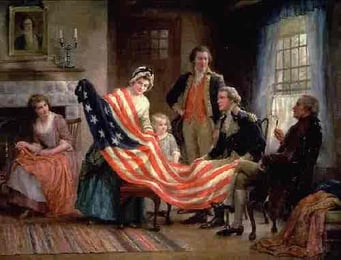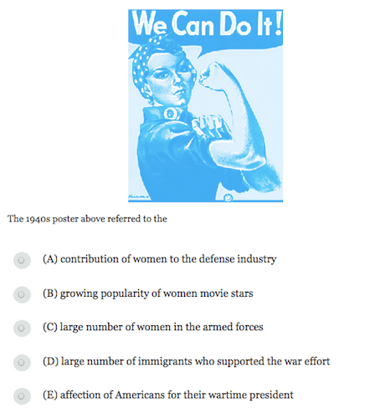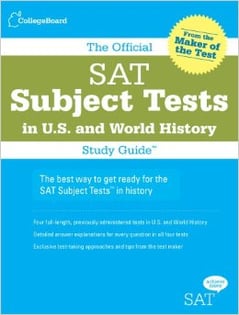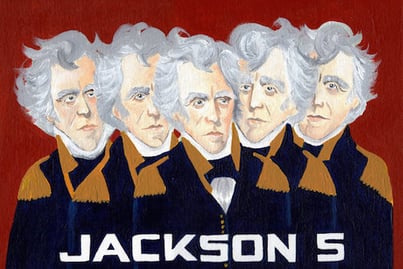
Alexander Hamilton, Lucretia Mott, Frederick Douglass, and Rosa Parks—these are a few of the important historical figures you might encounter on the SAT US History Subject Test.
This complete study guide will tell you everything you need to know for SAT US History, how you can prepare, and where to find the best practice questions to start prepping.
To help you find the exact info on the US History Subject Test that you're looking for, here's a table of contents so you can easily jump to the section you want:
Format of US History Subject Test
Types of Questions on US History Subject Test
Concepts Tested on US History Subject Test
Where to Find Practice Questions and Tests
How to Study for the US History Subject Test
When to Take the US History Subject Test
What Is the Format of the US History Subject Test?
Like all Subject Tests, SAT US History is 60 minutes. Within that hour, it asks you 90 multiple-choice questions.
Clearly, you'll have to develop your skills in answering questions quickly and efficiently! There are five answer choices per question, and the questions generally fall into three main types.
What Types of Questions Are On the Test?
The three main types of questions on the SAT US History are Recall questions, Analysis questions, and Using Data questions.
Recall Questions
Recall questions are relatively straightforward. They test your knowledge of specific facts, terms, and concepts. The following is a typical example of a "recall" question:
One purpose of the Marshall Plan of 1948 was to
A) rebuild European economies to make communism less appealing.
B) aid the depressed agricultural economies of Latin American nations.
C) aid communist nations that would agree to embrace democracy.
D) give military aid to those nations resisting communist subversion.
E) help the peoples of Asia establish heavy industries.
This question doesn't ask you to analyze or use data—either you have knowledge about the Marshall Plan of 1948 or you're out of luck (though you might be able to use the year, 1948, to make an educated guess). The correct answer is A) rebuild European economies.
Analysis Questions
Analysis questions also require your knowledge of a time period, important figures, or notable events, but they go one step further by asking you to apply that knowledge to analyze or interpret presented information, such as a quotation, map, graph, or cartoon. For instance, the following question gives a quote from the 1840's and asks you what idea it expresses, rather than simply asking for a description of the idea itself.
"If the Creator had separated Texas from the Union by mountain barriers, the Alps or the Andes, there might be plausible objections; but He has planned down the whole [Mississippi] Valley including Texas, and united every atom of the soil and every drop of the water of the mighty whole. He has linked their rivers with the great Mississippi, and marked and united the whole for the dominion of one government, the residence of one people." This quotation from the 1840s can be viewed as an expression of
A) The New Nationalism
B) popular sovereignty
C) Manifest Destiny
D) the Good Neighbor policy
E) the frontier thesis
You can see how this question requires you to interpret a quotation and place it in context of a historical trend. The correct answer for this (wildly outdated) quotation is C) Manifest Destiny.
Using Data Questions
The third type of question asks you to relate given data to history or to evaluate it. Data can be anything from a chart to a graph to a picture, like this famous image:

Rosie the Riveter is, of course, referring to A) the contribution of women to the defense industry.
Answering these recall, analysis, and data questions on the SAT US History calls upon the following skills.
Anticipated Skills on the SAT US History
These anticipated skills go along with the three types of questions. They are
- Historical concepts, cause-effect relationships, geography, and other data that you need for understanding major historical developments
- Concepts of historical analysis
- Ability to use knowledge to interpret data in maps, graphs, charts, and cartoons
You can probably see how these skills will be applied to recall, analysis, and using data questions. Now that you're familiar with the types of questions you'll see and the skills you need to answer them, what about the content on the test? Just how much US history do you need to know?
What Does the US History Test Cover?
The US History Subject Test ranges over several hundred years, from pre-Columbian history to the American Revolution to the Industrial Revolution to the present. Most of the focus is on the years after 1790, though there is a small portion that has to do with earlier history.
The exam includes political, economic, social, and cultural history, as well as foreign policy. Political and social history are emphasized more than the others.
The College Board gives the following breakdown of material and time periods:
| Political history | 31–35% |
| Economic history | 13–17% |
| Social history | 20–24% |
| Intellectual and cultural history | 13–17% |
| Foreign policy | 13–17% |
|
|
|
| Periods | % of Test |
| Pre-Columbian history to 1789 | 20% |
| 1790 to 1898 | 40% |
| 1899 to the present | 40% |

US History Subject Test Prep Materials
Now that you're familiar with the content and format of the test, let's talk about where you can find high-quality practice questions. Then we'll discuss the best ways to study effectively and strategies for succeeding on the test.
Test Prep Books
Official practice questions are always the gold standard when it comes to books for SAT test prep, so you can immediately look to the College Board. Their book includes two previously administered full-length practice tests, along with detailed answer explanations.
While this book is a good review, it's definitely not a replacement for staying focused throughout US History class. You'll need a solid foundation of historical knowledge in order to use this book effectively.
Books that offer a more detailed review of US History are Barron's and Princeton Review. Barron's has three full-length tests and a diagnostic test at the beginning to gauge your starting point. Its 40 or so chapters are divided by historical era.
Two cons about Barron's: it gives so much information that you might be studying needless facts and figures, and a lot of students say its questions are unnecessarily complex. Since you probably don't have a ton of time for Subject Test prep, you want to make sure you're getting the best results from your study time.
Princeton Review also gives a solid comprehensive overview, along with two full-length SAT US History practice tests in the book and an additional one online. It's a good resource in conjunction with your history class—just watch out for any questions that seem outdated. Starting out with official practice questions might help you develop your eye for this.
Kaplan is another option, but it's not your best resource. A lot of the questions are just too easy, so you'll probably get an unrealistic idea of your score from using its practice tests. I would recommend Kaplan the least for truly preparing for the US History Subject Test.
Finally, if you're taking AP US History around the same time as the SAT US History, you might want to check out No Bull Review: For Use with the AP US History Exam and SAT Subject Test. Keep in mind this book is not specific to the SAT Subject Test, but offers you strategies for combining your test prep, along with a review of history that will show up on both tests.
To sum up, if you're studying with books, check out College Board first, then Barron's and/or Princeton Review. Kaplan is not that helpful. For those of you also taking AP US History, No Bull Review can be a good supplemental resource.
What about online practice questions?
Online Practice Questions
Again, your first go-to should be College Board. Here it has 29 official practice questions and answer explanations. It also gives you some more practice questions and general advice in this PDF, though you'll have to self-correct and self-score them.
This site, 4tests.com, has 34 decent practice questions. They are a good, quick review that you can do and see them scored automatically.
Another site with a lot of online practice questions can be found here. It also has some helpful PDF downloads with key term glossaries and general review study guides. Finally, you can check out US history practice questions at Varsity Tutors which consists of several diagnostic tests for the US History Subject Test.

Study Tips and Techniques for the US History Subject Test
Whether you're using test prep books, online practice questions, or a combination, you want to make sure you're studying in the way that's most effective for you and your learning style. The following are some study techniques that will help you be truly ready for the SAT US History.
#1: Keep Up in Class
SAT US History covers a huge time period. It requires knowledge that spans several hundred years, and this knowledge takes time to learn, an entire year or more of studying US history in class.
Keeping up in class is essential to building a strong foundation of knowledge, as well as the skills of analysis and data interpretation that will be called upon in the Subject Test.
One way to keep yourself accountable would be to get an SAT US History test prep book in the beginning of the year, and use it for review as you go along through the course. This way you can reinforce the information and ensure that you can recall or apply it when answering Subject Test practice questions.
Gradual review over the year will be hugely helpful, and then you can do some more focused studying a couple months before the test, and really ramp up your studying two to three weeks before.
#2: Befriend the Practice Test
Practice tests are the best way to get ready. They don't just help keep you sharp and able to recall content and apply your skills, but they'll also help you develop your time management and pacing. Remember, the test asks 90 questions in only 60 minutes!
The Subject Tests don't change a huge deal from year to year, so any and all practice questions you can find will be helpful in some way (keeping in mind the recommendations I gave above).
There's a huge difference between passive studying and active test-taking. Taking practice tests will put your knowledge into action, as well as help you gauge your progress and identify which areas you need to focus more on.
#3: Score Your Practice Tests
Make sure to score your tests and understand the answer explanations. If you make a mistake or don't know a question, you should write that one down in a notebook so you can go back to it and fill in the gaps in your knowledge.
By periodically checking in throughout the year with SAT US History practice tests, you can gauge your progress and see your improvement over the year. Then you can really ramp it up in the weeks before the test.
#4: Analyze Your Wrong Answers
To repeat the point, you don't want to just score your test and move on. This score is a signal to you and what you know and what you need to learn.
You should figure out why you missed the question. Was it lack of knowledge, a wrong guess, or carelessness?
If the first, you should brush up on your understanding. Reread that section of history and take notes on it. If the second, work on refining your process of elimination skills. If you find yourself overly rationalizing or justifying an answer, it's probably a "distractor"—there's only one 100% correct answer choice. Figure out what was distracting you and get to the core of what the answer choices are communicating.
Finally, if the error was due to carelessness, continued practicing will help you improve your ability to read and comprehend a question and answer it quickly and efficiently. That's why timing yourself is such a good idea when taking practice tests. Which leads me to my next suggestion...
#5: Simulate Testing Conditions
Practice tests will give you the best "real test" experience if you simulate the testing conditions you'll encounter on test day. Give yourself exactly 60 minutes, no more, no less, and sit in a quiet space with few distractions.
After all your studying, you want to make sure you'll be able to get to all the questions and answer them thoroughly in the hour you'll be given.
Apart from practice tests and class materials, are there any other approaches you can take to learning the material?
#6: Get Creative In Your Studying
History involves a ton of reading and note-taking. If you find yourself feeling disengaged, you might want to try other approaches to make history come to life and engage with it in ways that are interesting to you. Reading aloud or watching documentaries, like on American Experience, could be a good way to supplement your understanding throughout the year.
Of course, these shouldn't be your main focus in the weeks leading up to the test, but try to find creative ways that will keep you interested in the people, places, and events of American history.

Test-Taking Strategies for the US History Subject Test
Beyond these study techniques, let's talk about some other important strategies you need to know to master the US History Subject Test.
#1: Note the Chronological Order of Questions
Questions on the US History Subject Test are grouped into 8 to 12 questions that go in chronological order. When a new grouping starts, you'll see a sharp change in the time period.
Understanding the time frame will help you comprehend the question, so pay attention to these groupings to make sure your head is in the right era.
#2: Use Process of Elimination
The US History SAT Subject Test deducts 1/4 of a point for every wrong answer, so you want to be strategic in how you answer the questions. If you can eliminate even one answer as incorrect, then I would recommend making your best educated guess.
Even if your mind goes blank after reading a question, you can generally apply your knowledge to eliminate wrong answers. While they are designed to all sound plausible, keep a sharp eye and look for "distractors" or answer choices that are irrelevant to the time period or content at hand.
#3: Take Time to Comprehend the Question
On a similar note, you want to make sure you really comprehend what the question is asking. Look for key words like EXCEPT or NOT, as well as superlatives like best, worst, all, none, always, or never. As you get better with time management, you'll be able to quickly get to the root of a question and its accompanying answer choices.
Finally, now that you know where to find practice materials, how to use them, and these test-taking strategies, when exactly should you take the US History Subject Test?
When to Take the US History Subject Test
The SAT US History Subject test is offered in August, October, November, December, May, and June, and the College Board recommends that you have at least a year of a college prep US History class before taking the exam. If you're taking AP US History, then you should be well prepared to take the test at the end of the year, and can combine your studying for both the AP test and the SAT. However, you can definitely do well even if you haven't taken AP.
It's best to take the test at the end of the school year. Remember, you can't take the Subject Tests on the same day as the SAT, but you can take up to three Subject Tests on one test date.
My recommendation for US History would be the June test date. You can read more about out other considerations for when to take the SAT Subject Tests and the full list of test dates here.
By keeping up in class, identifying and filling in your knowledge gaps, and prepping with practice questions, you'll be well prepared to conquer the US History Subject Test.
What's Next?
What's a good score for an SAT Subject Test? Actually, that depends on the Subject Test. Read about the good scores for each one here, along with what you need to know to get ahead of the curve.
Want to learn more about specific US History topics? We have discussions of Ida Lewis, the Platt Amendment, checks and balances, and how the executive branch checks the judicial branch. For some quirkier topics, check out our articles about the histories of the 3-hole punch and hip hop and the story of the Loomis Fargo heist.
Are you also prepping for the SAT? Use these free official SAT practice tests as you get ready for the test.
Want to improve your SAT score by 160 points or your ACT score by 4 points? We've written a guide for each test about the top 5 strategies you must be using to have a shot at improving your score. Download it for free now:
These recommendations are based solely on our knowledge and experience. If you purchase an item through one of our links, PrepScholar may receive a commission.
Have friends who also need help with test prep? Share this article!

Rebecca graduated with her Master's in Adolescent Counseling from the Harvard Graduate School of Education. She has years of teaching and college counseling experience and is passionate about helping students achieve their goals and improve their well-being. She graduated magna cum laude from Tufts University and scored in the 99th percentile on the SAT.



































 Holly R.
Holly R.